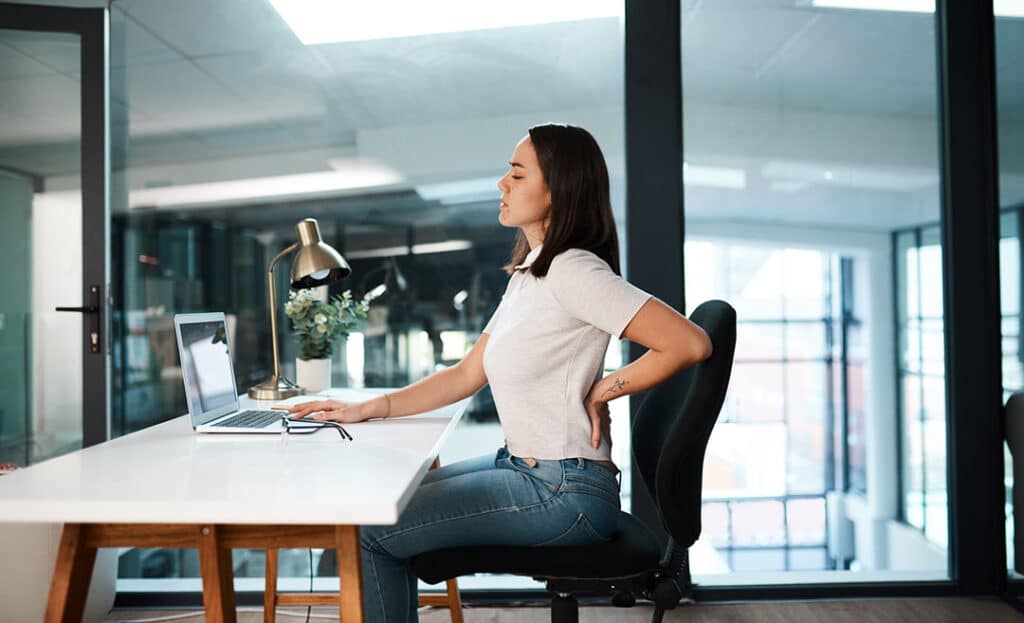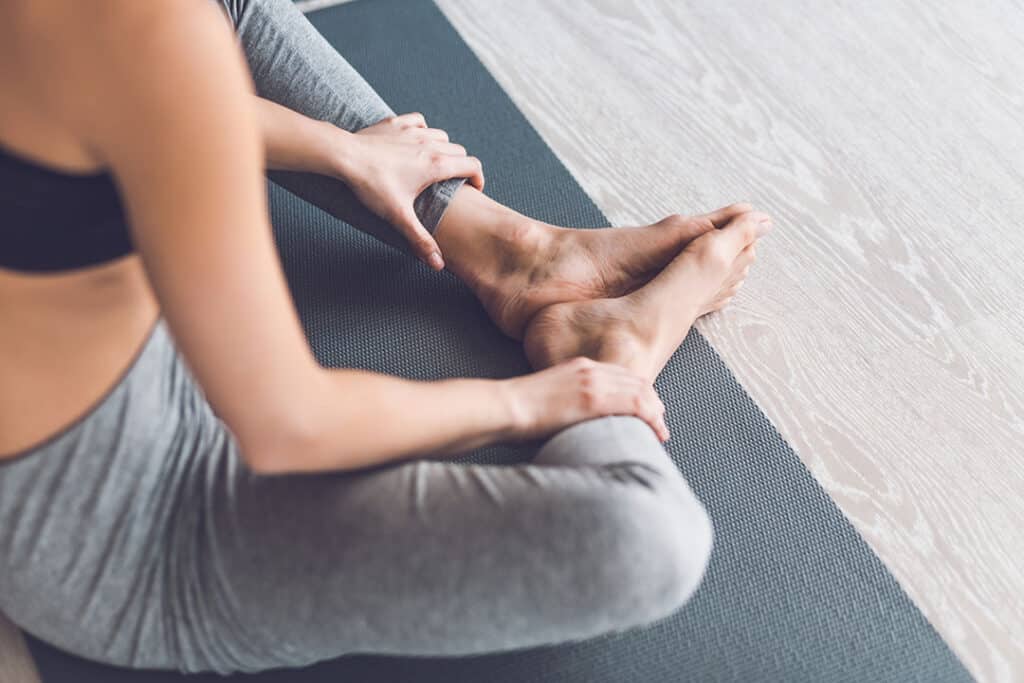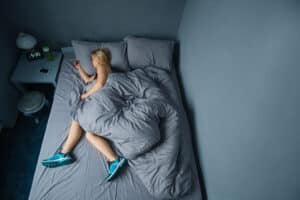Ready to finally get to the root of your back pain? Understanding the hip flexors’ role in your body is the first step to finding natural relief.
When your low back is aching, your first thought might be to practice more back stretches, build up your back muscles, or even put heat or ice packs directly on the back. While these can help reduce the pain, they may not be getting to the real root of the problem.
But if low back pain isn’t stemming from your back, where does it come from? For many of us, low back pain actually originates in the hips. Tight hip flexors (the muscles that move your hips forward) are a common issue that leads to issues like low back pain and sciatica.
Keep reading to learn more about the role hip flexors play in managing back pain and some simple tips on how to get lasting relief.
Understanding Hip Flexors

The hip flexors are a group of muscles located in your hips and upper thighs. As their name suggests, they are responsible for flexing (bending) your hips.
When your hip flexors contract, they cause your hips to bend and your knees to lift toward your chest. These muscles work along with your glutes, quads, and hamstrings to support your spine and pelvis during activities like walking, running, climbing, and jumping.
There are several different muscles that make up your hip flexors:
- The psoas major is one of the largest muscles in your body, and it attaches to your lower spine and your femur.
- The iliacus muscle is located in your pelvis and it connects to the same part of the femur as the psoas major.
- The rectus femoris muscle is one of the four quadriceps muscles, running all the way from your pelvis to your knee.
- The tensor fasciae latae (TFL) is located on the side of the hip and runs from the pelvis to the femur.
- The sartorius is the longest muscle in the body, running from the hip to the knee, and is located on the front of the thigh.
The Link Between Tight Hip Flexors and Low Back Pain

While many people think their back pain is caused by issues with the spine or spinal muscles, oftentimes, tight hip flexors are actually to blame.
Because the hip flexor muscles are directly linked to the lower spine, any tightness or weakness of these muscles can easily affect the lower back. This causes a chain reaction throughout your body that can lead to pain and discomfort. Most often, tight hip flexors cause the pelvis to tilt forward, which creates too much curvature in the lower back. The increased curvature puts additional stress on your low back muscles and causes them to become fatigued and sore. Over time, this leads to that chronic ache in your low back.
How do our hip flexors become tight? The most common root cause is our lifestyle. If you spend most of your days sitting or doing sedentary activities, you could be at a high risk of developing tight hip flexors. Sitting for extended periods of time can cause your hip flexors to shorten, which leads to stiffness and reduced mobility.
Aside from sitting for long periods of time, other factors can also cause you to develop tight hip flexors. For example, certain exercises and activities that involve repetitive hip flexion (especially cycling or running) can cause these muscles to become tight and stiff.
Common Signs and Symptoms of Tight Hip Flexors
Tight hip flexors are a common cause of low back pain, but they are certainly not the only cause. Here are some common signs that tight hip flexors are a factor in your low back pain:
- Low back pain, hip pain, or knee pain while running or walking
- Discomfort or pain while sitting or lying down
- Pain when getting up from a seated position
- A pinching or snapping sensation in the hip when moving
- Difficulty or pain extending your leg behind you
- Reduced hip mobility
4 Reasons to Stretch and Strengthen Hip Flexors

If you want to fight muscle tension, tightness, and pain, stretching is a must. Stretching and strengthening exercises are a simple way to loosen tight hip flexors and improve your back pain every day, right from home. Here are some of the ways that stretching can help to alleviate tight hip flexors:
> Relieves tension immediately
Stretching is a natural way to alleviate tension and promote relaxation in the muscles. Stretching the hip flexors can help to relieve tension in the lower back, hips, and legs, which can reduce pain and discomfort.
> Improves range of motion over time
Tight hip flexors can limit the range of motion in the hips and lower back. Stretching these muscles improves flexibility and increases range of motion, so you can move with more ease and less strain on the lower back.
> Enhances circulation
Healthy blood flow means healthier muscles – and less pain. Stretching can help to improve blood flow to the muscles and reduce the stiffness that causes pain.
> Prevents injury
Tight hip flexors can make the lower back and hips more susceptible to injury. Stretching these muscles can help to improve the overall health of your hip flexors so you are less prone to hip and back injuries.
5 Hip Flexor Exercises to Try

1) Seated Forward Fold
The Seated Forward Fold stretches and lengthens the hip flexors and hamstrings to ease tension in the lower back.
- Sit on the ground with your legs extended in front of you.
- Hinge forward at the hips, reaching for your toes.
- Hold for 20-30 seconds before releasing the stretch.
2) Lunges
Lunges stretch the hip flexors and build strength in the lower body.
- Stand with your feet hip-width apart.
- Take a big step forward with one foot, lowering your hips toward the ground until both knees are at 90-degree angles.
- Hold for 20-30 seconds before returning to standing. Repeat on the other side.
3) Pigeon Pose
Pigeon Pose is a yoga pose that works to stretch the hip flexors, glutes, and lower back. It is particularly helpful for those who sit for long periods of time.
- Start on your hands and knees. Bring one leg forward and place it in front of your body with your knee bent at a 90-degree angle.
- Extend the other leg behind you and lower your hips toward the ground.
- Hold for 20-30 seconds before switching sides.
4) Butterfly Stretch
The Butterfly Stretch is a simple exercise that stretches the hip flexors and inner thighs.
- Sit on the ground with the soles of your feet touching and your knees bent out to the sides.
- Gently press down on your knees with your hands to deepen the stretch.
- Hold for 20-30 seconds before releasing.
5) Bridge Pose
Bridge Pose is a yoga pose that works to stretch the hip flexors, glutes, and lower back while also building lower body strength.
- Lie on your back with your knees bent and your feet flat on the ground.
- Lift your hips off the ground, squeezing your glutes as you do so.
- Hold for 20-30 seconds before lowering your hips back down.
Tips for Stretching Safely

Before you dive into these or other hip flexor stretches, it’s important to practice safe and proper stretching techniques to avoid overworking or further injuring your muscles.
Before beginning your stretching routine, always take a few minutes to warm up. Stretching “cold” muscles can lead to muscle tears and strains. Warm up with light cardio (like a brisk walk or jogging in place) to get your blood flowing and your muscles ready to stretch.
When you’re ready to start, begin with gentle stretches and gradually increase the intensity and duration over time. Don’t ever force your body into uncomfortable positions. Then, be sure to hold your stretches for long enough. Aim for at least 20-30 seconds and repeat several times on each side.
Consistency is also key when it comes to stretching properly. Make it a daily habit, preferably at the same time each day, to maintain flexibility and reduce tension.
Last but not least, listen to your body. Pay attention to how your body feels during your stretch. If you experience pain or discomfort, adjust the stretch or stop altogether. Reach out to your local AlignLife clinic to get tailored exercise advice to best support your unique situation.
Preventing and Managing Low Back Pain

Living with low back pain can be frustrating, but there are several ways to manage it without having to rely on pain medications or giving up your favorite activities. In addition to stretching and strengthening your hip flexors, there are a few other steps you can take to prevent and manage low back pain.
> Prioritize good posture
One of the most important ways to prevent and manage low back pain is to pay more attention to your posture and alignment. How you sit, stand, and even sleep can ultimately impact the health of your low back.
Try sitting and standing with your shoulders back, your chin tucked in, and your pelvis in a neutral position. This helps reduce the stress on your lower back muscles and keeps your spine in alignment. Then, take it to the next level with stretches for posture support and flexibility.
If you tend to slip into bad posture habits (like crossing your legs, slumping your shoulders, or pushing your head forward, regular “posture checks” throughout the day can help you remember to stay in alignment. Set an alarm for every 20, 30, or 60 minutes to check your posture and adjust if needed. Eventually, you’ll train your body to take a healthy stance naturally.
> Sit less, move more
Prolonged sitting is one of the biggest factors that contribute to tight hip flexors (and therefore low back pain). By reducing the time you spend sitting, you’ll prevent the shortening and tightening of these muscles and prevent low back issues.
If you spend most of the day sitting at your desk, in a car, or elsewhere, make frequent breaks a daily habit. Take a few minutes to stand up and stretch at least every hour, or more often if you can. You may consider getting a standing desk, or taking the stairs whenever possible. Challenge yourself to park farther away from your destination to build more steps into your day naturally.
> Make time for exercise
Beyond your daily stretching routine, it’s important to engage in regular exercise. Exercise is not only important for your overall health, but it is also essential for preventing low back pain. Activities like walking, swimming, or yoga are great for easing pain and stress, all while strengthening the core muscles. Together, this improves your flexibility and mobility and reduces your risk of low back pain.
> Maintain a healthy weight
Carrying around excess weight is one of the leading causes of low back and hip pain. By maintaining a healthy weight, you can reduce the stress on your lower back muscles and hip flexors, reduce inflammation, and enjoy a healthier lifestyle overall.
But, many people struggle to lose weight in a sustainable and lasting way, because most weight loss diets aren’t customized to their goals and circumstances. At AlignLife, we do things differently. Our weight management program is tailored entirely to you, so you can achieve and maintain your healthiest weight in less time, with less stress.
> Get holistic support
Whole-body therapies are essential if you want to manage any kind of chronic pain condition naturally. In fact, low back pain is one of the most common reasons patients seek out help from health professionals such as chiropractors or acupuncturists.
Beyond relieving pain, chiropractic care and acupuncture support a healthy back and hips, improve your posture, and help to prevent low back pain from returning. Your AlignLife clinician will get to the root cause of your low back pain and provide treatments to keep muscles strong yet flexible and your spine aligned, as well as recommend stretches and exercises to promote a healthy back and hips.
Heal Your Back Through Your Hips

Sometimes the key to a healthier low back lies in the hips. If you’re struggling with low back pain that worsens with walking, sitting, or repetitive hip movements, tight hip flexors could be at the root of the problem.
Thankfully, incorporating exercises that stretch and strengthen your hip flexors into your daily routine, as well as some simple lifestyle changes, can make a huge difference. Just remember to consult with a healthcare provider before starting any new exercise or treatment plan.
At AlignLife, we’re here to help you get on the right path to relief. If you’re experiencing persistent low back pain or hip discomfort, schedule an appointment with AlignLife to get the personalized care and support you need to move pain-free.



